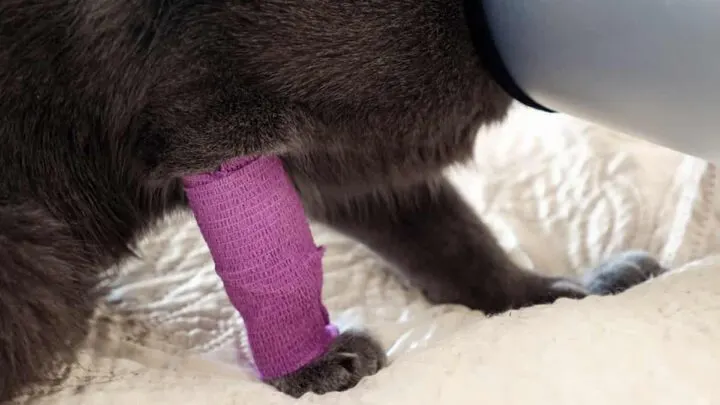We cover many fun topics here on FAQCats, but none are quite as interesting as what cats may do to get their way. Cats are known for being clever, but a recent viral Tiktok video suggests they’ll take things as far, such as fake limping for sympathy.
But is it truth or myth? Will cats fake limp for sympathy?
Cats can indeed fake limp for sympathy. This is not a common occurrence, and to some degree, cats must be conditioned to show this behavior if it’s been rewarded with sympathy in the past.
Read on to learn more about how this can happen and what you can do as a cat owner to prevent your feline friend from taking advantage of you!

The Viral Video Everyone Is Talking About
Still, trying to figure out if a cat would fake a limp for sympathy? Well, prepare to be amazed. This viral TikTok video shows a cat fake limping to get its way from its owner. However, what looks like a display of cuteness can quickly turn into being taken advantage of if you’re not careful with your cat.
In the video, you can see the cat “Edward” holding up a paw with a plain expression on its face. The owner shows their distaste, saying, “not this again.” Edward persists in keeping up the act even as the owner pets them. Edward turns and continues the limp, even hopping around on the three legs.
It’s fascinating to see and oddly entertaining if you’re a cat lover. However, you may notice as you watch that Edward starts walking normally and even stretching shortly after getting pet. As if nothing happened!
Even later in the video Edward, the cat is seen switching which paws they are limping from!
Why Cats Would Do This
Although there is some science behind cats and their desire for attention, there’s only a little out there specifically about limping to garner that attention.
However, animal behaviorists have conducted some studies such as this one that show perfectly healthy cats can sometimes exhibit behaviors associated with sickness and pain.
As mentioned earlier, a cat that fake limps does so with the expectation that you’ll return the favor with attention. It’s a learned behavior that a cat owner wasn’t likely aware of at the time, and it’s been rewarded to the point of them reusing it effectively.
It’s no different than a cat crying until you give them a treat or scratching at your toes until you pet them.
In the case of a fake limp, it could be related to something that happened in the past.
For example, if your cat was injured before and had a limp, you presumably gave them a great deal of attention. Sometimes, it just takes one series of events for them to understand what comes with it. Lots of care treats and much more.

How Can You Pick Out A Cat That’s Faking It
Now that you understand it’s a learned behavior, now comes the challenging task of deciding whether to believe your cat or ignore them. That’s not always an easy position to be in, but there are a few things you can do to help figure this out.
- First, check your cat for signs of swelling and marks.
- Next, try leaving the room for a few minutes to see if they return to their typical walking pattern
- Place hidden cameras in your living space to observe your cat’s behavior over time
- Check your cat’s reaction to touching their leg
- Observe your cat for lethargy and lack of an appetite
That’s all there is to it. On the first account, any limping should be accompanied by swelling or bruising. Many times you can see the exact area of impact, which will show some redness and maybe even cuts. If your cat doesn’t have this going on, they are probably faking the limp.
Leaving the area for a few minutes does two things. It shows your cat you’re not interested and allows you to catch them in the act. If you return and they suddenly drop back into their limp with their soft meows, you know you’ve got a sneaky cat on your hands.
In our home with our cat Harley, we have cameras. Those are mainly to check on him whenever we leave for an extended period, but in the case of limping, it can be helpful to catch them in the act too. By the way, he doesn’t fake a limp!
Moving on, checking your cat’s reaction when you touch the suspected area of pain is an important step. A cat in pain will likely react aggressively to any contact with that area. That may be a hiss, a growl, or a sudden snatching away. Those are clear signs a cat is genuinely in pain.
And last but not least, observe your cat for other odd behaviors. Cats who become lethargic and stop eating are dealing with serious issues.

My name is James, and welcome to FAQCats!
Along with our team of cat owners, expert pet enthusiasts, and pet professionals, we aim to write engaging helpful, engaging content about cats. At FAQCats we strive to provide content that’s accurate and fun to read. Our team writes about everything related to cats; even the most complex of topics. Through extensive research and caring for our own fur-pals, we’re able to provide something cat owners worldwide will love. Have a look around, and leave us feedback anytime!

